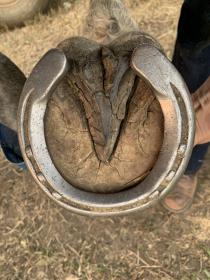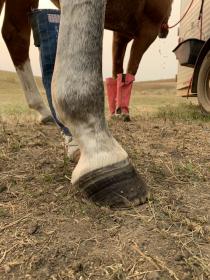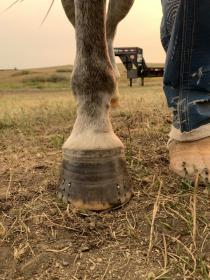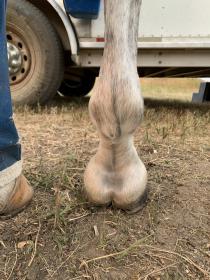Vet and I are trying to figure out why my 9-year-old trips so much over his front feet. I’ve owned him since he was 6 months old and he has always been one of those horses that stumbles over his front feet (lazy, drags his feet) but it has seemed worse this year. And he stumbled badly on the first barrel on two different barrel runs recently, and stumbled badly at the end of a pole bending run when coming to a stop, so I needed to investigate.
When he was 4, he had a minor tendon injury to the right front which never caused him any problems but we caught it early on a “routine” lameness eval. Since then, he has always flexed slightly off on that foot, even though it completely resolved. At least … that is what we have assumed. Last week, we decided to nerve block (since it’s been several years) and make sure that’s what was bothering him and causing the tripping and it WASN’T! (Much to both of our surprise.) I’m not technical but we did 3 blocks and it made no improvement whatsoever on his way of going on the right front. So it’s higher up somewhere.
Vet really didn’t think it was his knee or shoulder, so we chose not to block or x-ray the knee, and I know she did a neurological exam (she was crossing his front legs over to see what he did). She suspected his neck. He has always been a stiffer-type horse his entire life so that didn’t present any red flags for me, but she felt he was a lot less flexible to the right. We did x-rays and she could see some mild changes at C5/C6.
She’s also going to send them off for second opinions. So she did a shockwave treatment for him that day. (5 days ago) to hopefully help with mobility. I have already had him checked by a chiro this year, but I know it will be more important going forward and may need to do it more often for him. He’s also already had some PEMF treatments this year. Already on Adequan.
Neck issues are a new territory for me, so just curious to hear other’s stories of what neck problems your horse has and what you do to help them the best you can.







 Interesting on the pentosan. I put my other horse on it this year (with issues) and I have been astonished how much it has helped him. Definately going to try it for the grey too. But I want to do one thing at a time in order to gauge how much each thing helps.
Interesting on the pentosan. I put my other horse on it this year (with issues) and I have been astonished how much it has helped him. Definately going to try it for the grey too. But I want to do one thing at a time in order to gauge how much each thing helps.